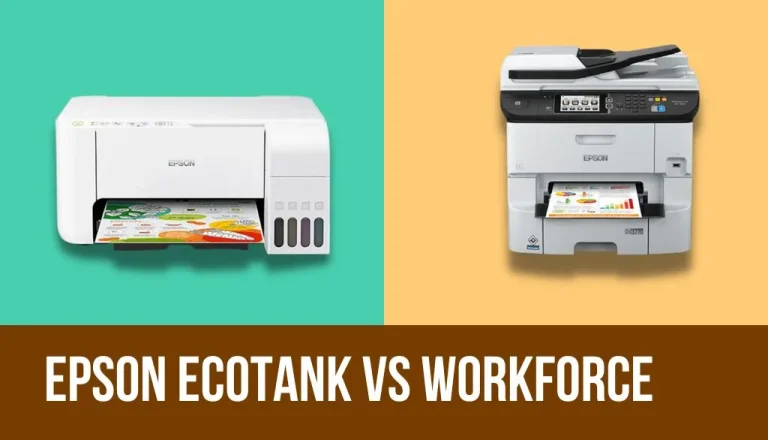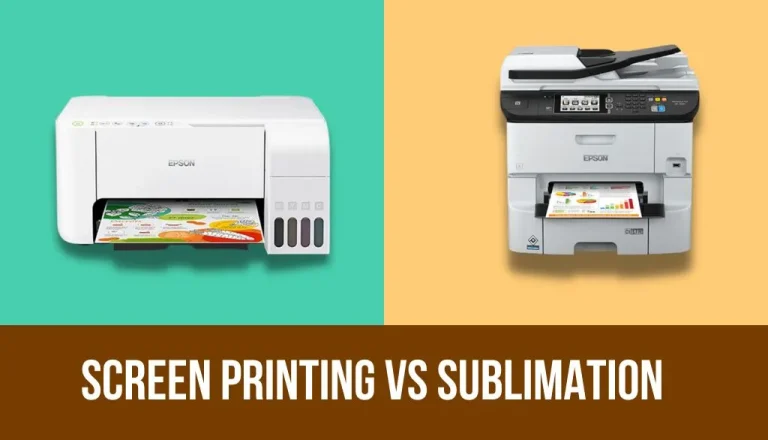Screen Printing vs Heat Transfers vs Sublimation: Key Differences
Sublimation is the most popular process of printing images than objects. This process helps in printing special designs such as t-shirts mugs or more. You can also compare it with heat transfer or screen printing.
In this article, I will explain the difference between Screen Printing vs Heat Transfers vs Sublimation. And what is the difference between these three different eco-solvent processes? So just read till the end.
Difference between Screen Printing vs Sublimation?
It is applied to shirts differently with screen printing and sublimation. By screen printing ink is pushed through s stencil onto the fabric and by sublimation dye is chemically bonded to the fabric fibers.
As a result of the different printing methods used in each method, both methods produce high-quality designs.
1. Durability
Screen-printed designs do not last as long as sublimation prints. Despite many washes screen prints eventually crack or peel away from the fabric due to raised ink designs.
Dye bonds beneath the surface of the fabric so sublimation designs will never crack or peel. T-shirt design was considered one of the most durable forms of printing before the invention of sublimation.
Screen printing lasts longer than sublimation but it is more durable than sublimation. A special type of dye known as plastisol ink is used in screen prints to ensure long-term durability.
2. Quality
The quality of both Screen Printing vs Heat Transfers vs Sublimation designs is high they do so in different ways. With sublimation printing the colors are vivid and bright and will not fade over time.
As well as creating detailed and multicolored images this printing method is also famous for its ease of use.
Screen prints create raised designs with fewer colors that provide a contrast of colors and textures that are bold and tactile. DTG prints do not look as classy as these and they last much longer than DTG prints.
3. Complexity
Screen printing allows for a more complex design than sublimation printing most of the time. When using the sublimation method you print a digital image right onto a transfer paper. Making a stencil is the first step in making a screen print.
The process of making detailed stencils usually involves making a complicated light emulsion that functions much like a negative. Making a detailed screen print stencil requires a lot of chemical skill and patience.
4. Consistency
You can reproduce the same design consistently using both screen printing and sublimation. Ink smudging or dust stuck in the design could cause minor discrepancies with both methods.
Because you can reuse your color screens many times screen printing has a pretty good consistency.
There may be slight variations between designs over time such as a smudge here and there. Design consistency is achieved through screen printing.
As a result of sublimation printing you can also make duplicate shirts simply by printing your digital image onto transfer paper again.
Because the transfer paper needs to be set up carefully you have to avoid ghosting caused by moving transfer paper or dust smudges caused by bits of lint stuck to the fabric.
5. Cost efficiency
Sublimation is more cost-effective for making custom-ordered t-shirts. Scren printing however is more cost effective if you need to order many copies of one design at the same time.
Setting up a screen print takes a lot of time and effort so making just one or two shirts would cost a lot. It is worth the time and effort if you can reuse your screen ten twenty or one hundred times for the same order.
It takes the same amount of time and effort to make a shirt using Screen Printing vs Heat Transfers vs Sublimation printing. Making one shirt can be just as cost-effective as making ten since it doesn’t take as much time.Multi-colored prints:
Multi-colored prints work much better with sublimation than with screen printing. As a result, screenprinting requires you to separate the colors and apply them one at a time.
A screen printer often uses a large machine with many arms each holding a screen so that multiple colors can be applied to an image. Setup is time-consuming and requires a lot of work.
It is easy to create multi-colored complex images with sublimation printers since they mix primary colors. However white fabric is the best fabric for these designs. Darker materials will not show the designs well.
Why does sublimation work best on white fabric? For two reasons. First, a printer working with the CYMK model cannot create white ink. When you think about it you can’t mix colors to make white.
This means that you have to leave negative space in a photo or image where you want the white fabric to show through.
Secondly, if you print blue ink onto blue fabric you will not see the blue ink very well. You need the contrast of ink and light fabric to see a sublimation print. This is a big advantage of screen printing which works just fine on any color of shirt.
6. Color Blending
There is a lot of difficulty in getting shades of colors just right when it comes to both sublimation and screen printing though each method has its differences. It is usually necessary to mix the shades of color by hand when screen printing.
Computerized paint-blending machines may be used by professionals. However, depending on the project mixed shades could vary.
Creating cool ombre effects sometimes takes blending colors directly onto the screen but it also requires skill.
The first glance of sublimation print seems to suggest that blending coolors is easy. Printing onto transfer paper requires mixing CYMK colors which is done automatically by your printer it’s not all sunshine and rainbows through.
ICC profiles are required for accurate color reproduction in sublimation printing. Our perception of colors and how computer screens display colors are not the same as how printers mix inks, a printer can create accurate blended colors by matching the computer screen with the ICC profile.
7. Set up Time and Costs
Screen printing generally takes longer to set up but sublimation prints may cost more. Your choice of design will greatly influence this, however.
Printing the image onto a transfer paper is the first step in setting up sublimation printing. Cutsom-ordered transfers can even skip this step for you if you want someone else to handle this for you.
Screen printing requires a lot of setup time. Even for a simple one-color design. You have to make the stencil and apply ink to the screen. For designs with more than one color, you have to make a separate stencil and screen for each color.
The cost for each printing method comes down to the equipment you need in most cases. For Forsublimationn you need a special printer and sublimation inks. You also need graphic design software transfer paper, polyester shirts, or other polymer-coated blanks.
For screen printing, you can buy expensive equipment or you can work with homemade mesh screens that you make yourself out of cheap craft equipment.
You will need expensive plastisol ink either way but you can make screen printed without spending a lot of money if you want. That said both screen printing and sublimation require a heat press.
8. Quantity
While sublimation can create duplicate designs screen printing is easier for printing large qualities of t-shirts. The same screen can be used to screen print many duplicates once you have set them up. Moreover, the same stencil must be reapplied and pushed through over and over.
The same design can be printed multiple times onto transfer paper for sublimation printing. Once the transfer is applied to each shirt you need to use your heat press to set it.
it is easier to print small quantities with sublimation however because this method doesn’t require a lot of setup time you can afford to make just one or two duplicates.
Heat Transfers vs Sublimation:
1. Durability and Feel
As opposed to adding a layer on top sublimation makes the ink part of the fabric. In this way a transfer is achieved that is both durable and comfortable. Heat transfer paper on the other hand adds a layer to the top of the garment.
With repeated washings, this additional layer can become faded and cracked and is less durable than sublimation.
Heat transfer papers are not all the same and some are softer and more durable than others. For those just getting started with inkjet printers we recommended JETPRO soft. Which has a soft texture and great durability.
2. Types of Garments you can Decorate
Compared to heat transfer paper you can’t decorate as many fabrics with sublimation. The first thing you need to know is that sublimation only works on polyester fabrics. You can’t have 100% cotton.
The reason for this is that sublimation ink only adheres to polyester materials. The transfer will not be as vibrant and bright as it is on 100%polyster but you might be able to get away with sublimating on some poly-cotton blends.
For your transfer to show your fabric must also be white or very light-colored since sublimation doesn’t add an extra layer.
Heat transfer paper on the other hand can be used to decorate light and dark-colored cotton polyester and cotton-poly blends
3. Types of Garments you can Decorate
Sublimation is more limited than heat transfer paper when it comes to what fabrics you can decorate. First sublimation only works with polyester fabrics. No cotton that is 100%.
Polyester is the only material that blinds sublimation ink.
The transfer will be less vibrant and bright on poly cotton blends when sublimated but it is possible. The material must also be white or very light-colored for your transfer to show because sublimation adds an extra layer to the fabrics.
Conversely, heat transfer paper can be used to decorate cotton polyester and cotton-poly blends in light and dark colors.
Frequently Asked Questions:
Cotton fabrics are best suited for screen printing since the ink adheres better to them. Polyester blends, polymer-coated fabrics, and light-colored polyesters are ideal for sublimation printing.
As the screen print soaks into the fabric, it becomes more durable. The layered colors of screen prints penetrate the fabric better than heat press transfers. Heat transfers are more cost-effective than screen prints for small orders, however.
You won’t feel the image on the shirt or surface since sublimation occurs when the polyester fabric is dyed. The hand is very light. A heat transfer paper design eventually cracks, whereas this design is more durable and won’t.
Heat transfer prints on top of the fabric to know screen printing vs. heat transfer. ‘s sublimation, while screen printing soaks into the fabric. Heat transfer or sublimation can be better printing options for fabrics like polyester and spandex that are difficult to screen print.
A vinyl-printed, dtf shirt will usually last for several years before fading. Shirts that are screen printed, however, will last the entire life of the shirt. Compared to other types of printing, screen printing is more resistant to wear and tear and washing.
Final Verdict:
There are many advantages and disadvantages to Screen Printing vs Heat Transfers vs Sublimation when it comes to creating custom garments and other products.
Custom garments with simple or complex designs, products on a variety of materials, and large orders are all good candidates for screen printing.
For small batches, it can be expensive and time-consuming, but it is a durable and versatile printing method.
You can use sublimation for custom garments with full-color designs, ceramic mugs, and other hard goods, as well as small batches of custom products.
This printing method is fast and easy, and the prints are durable and resistant to fading and cracking. Sublimation, however, only works on polyester fabrics and light-colored materials.
Your specific printing requirements and needs will determine what method is best for you. It is always best to consult a professional printer if you are unsure what method would work best for you.













